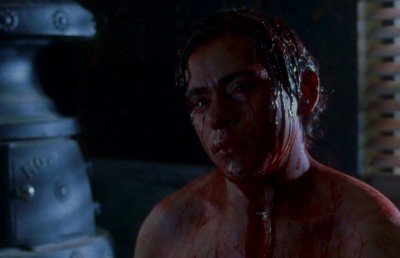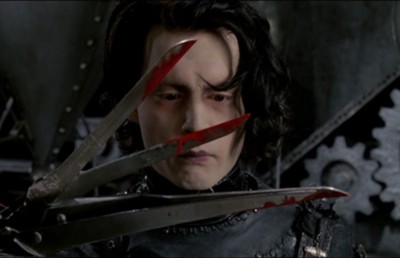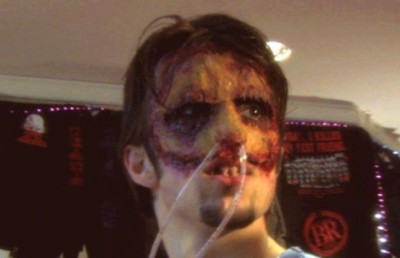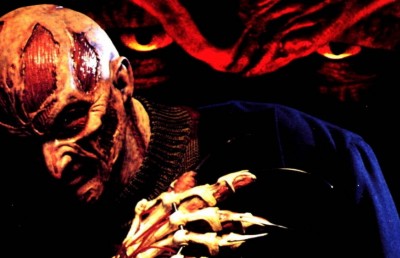It is Violence that Undoes the Man
Representations of the Modern Male in Alexandre Aja’s The Hills Have Eyes
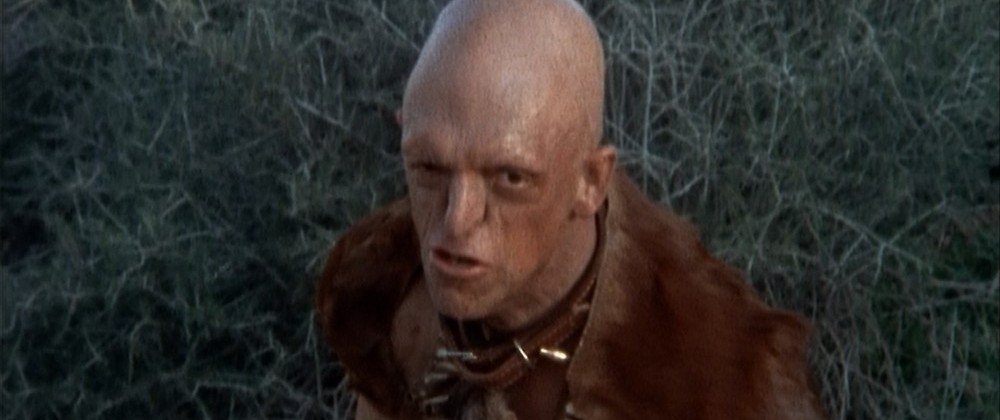
Wes Craven concluded his original The Hills Have Eyes (1977) on a freeze frame: having wreaked a violent retribution upon those who had inflicted a litany of violent acts upon his family, Doug Wood stands over the cannibal Mars. Without hesitation, he repeatedly plunges a hunting knife into Mars chest. As Doug withdraws the knife for the last time the movement stops. That frozen moment fixes Doug’s maniacal expression, blood, sweat and spittle dripping from his face. This image is a culmination of Doug’s narrative and psychological events whereby this modern man who, for all his pretence at civility and domesticity, not only harbours considerable repressed rage but is also one who has retained his primitive instincts. In both Craven’s film and Alexandre Aja’s remake (The Hills Have Eyes, 2006), that repressed rage is poked, cajoled, and pushed until it is released through an act of stark and primitive violence. For Craven, ending the film with that still image of destructive frenzy consolidates the narrative’s purpose, implying that a safe and domesticated society may not be at all possible. It is a bleak ending and one which repeats the themes of Craven’s 1972 debut The Last House on the Left: in both films a middle-class family comes into conflict with a group of aggressive outsiders. As the violence escalates the bourgeois family reverts back to a primitive state and commits violent acts in retribution for the equally primitive and violent acts perpetrated against them. Throughout the narrative both groups are paralleled and then finally become interchangeable through their violence. Progress, technology and modern civility are suddenly undermined and then made redundant as they are perverted by primal response.
Although twenty-nine years have passed since its first release, the possible interpretations of Craven’s narrative are as relevant now as they were back then. Given this Aja and writer Grégory Levasseur choose not to drastically alter Craven’s original story for their recent remake. This adherence is in some ways a hindrance for they change very little in terms of narrative structure and so the critical readings of Aja’s film are, to some extent, as equally applicable to Craven’s original. But, to their credit, Aja and Levasseur do make minor alterations, most notably to Doug Wood’s narrative. In addition to changing his surname, they place Doug into more psychological and physically gruelling conditions and so amplifying his violent transgression. In a responsive balance to this, the mutant family is given a greater identity by living in a semblance of a normal home, a nuclear test site village. Both changes lend weight to the film’s critical readings, predominately making the growing similarities between the two families, as much as their initial difference, more obvious.
Aja and Levasseur’s film places great emphasis on the notion of the family, setting their narrative within the occasion of Big Bob and Ethel Carter’s twenty-fifth wedding anniversary. To celebrate they are taking their family and son-in-law, Doug Bukowski, on vacation to San Diego. Having hitched up the mobile home and filled up the car with diesel, they drive off into the New Mexico desert. This should be a happy time, the family coming together for one last vacation before the youngest Carters, Bobby and Brenda, leave for college and Lynne, her husband and their baby daughter Catherine, settle down into their own family life.
The innocence of their holiday is quickly diminished as the car crashes, being damaged beyond repair. Immediately taking charge of the situation, Bob decides that Doug and he will walk in opposite directions on the road to find help. While they are away, the remaining Carters set up a temporary home, unaware that they are being watched by a family of mutant cannibals. By nightfall, Doug has returned but without help. Deciding to wait for Bob’s return, the family try to get some sleep but are awoken by an explosion: outside the mobile home, Bob has been captured by the mutants who have crucified and immolated him. While Ethel, Bobby, Lynne and Doug try to save Bob two of the mutant family —Pluto and Lizard— enter the mobile home and rape Brenda. As Pluto continues to beat Brenda, Lynne disturbs the mutants who then attack her. The violence of the assault escalates and culminates in the murder of Ethel and the execution of Lynne. Before making their escape, Pluto and Lizard kidnap baby Catherine. In the aftermath of the assault, Doug, the only adult male left, realises he has no choice but to go after his daughter alone. And so, taking a baseball bat, screwdriver, and the family dog, he goes into the desert to rescue his daughter.
It is obvious from the start that Big Bob Carter disapproves of Doug Bukowski. There is verbal conflict between the two during almost all of their conversations, with Bob’s comments often attempting to undermine Doug or at least highlight his inadequacies. Even when Doug tries to help, Big Bob refuses his assistance and turns it into another opportunity for denigration. As a result of these constant criticisms and rejections Doug’s anger towards his father-in-law steadily increases. When he attempts some sort of release through criticising Bob, his wife intervenes and prevents him from doing so. Although seemingly diplomatic, Lynne is in fact only increasing Doug’s anger and again demonstrating his weakness before Big Bob. Without the opportunity to either prove his worth or release his anger, Doug’s repression becomes a resentful anxiety that renders him as an ineffectual male, a college boy who has had no real experience of life in comparison to Bob, the ex-detective.
Within the context of the horror genre, Doug’s lack of experience and repression make him the ideal character for transition, the one who will be forced to engage with situations that are out of his understanding and abilities. Given this, Doug’s movement through the film can be interpreted as a rite of passage: by releasing his repressed anxieties and rage he can become the man Bob expects him to be, the patriarchal protector of his eldest daughter and grandchild. In essence, he wants Doug to be the mirror of himself. This need to fulfil such a masculine role permeates through the film to the extent that Doug’s ineffectual nature is made even more prominent, particularly when the females within the family demonstrate greater awareness and strength. [1]
This aspect of Doug’s narrative arc is a dominating motif within genre cinema. Films that use such initially weak characters (such as The Texas Chainsaw Massacre (Tobe Hopper, 1974) and its remake (Marcus Nispel, 2003), Jaws (Steven Spielberg, 1975) Wrong Turn (Rob Schmidt, 2003), Hostel (Eli Roth, 2005) and Wolf Creek (Greg McLean, 2005) alongside the glut of Stalk and Slash films of the 1980’s) predominately place the repressed modern domesticate into a wilderness environment. Without the aid of technology they must overcome their passive nature and fight as a primitive, using their new found strength —the capacity to commit violent acts— as a means of resolving situations as much as a means of survival. By doing this, it will be their role and their role alone to kill the antagonist. Upon completing this act they are redeemed of their former self but also transformed. Their transition is ambiguous for the situations they have experienced and survived are irreversible and so they return to society not as the modern domesticate but as the modern primitive: aware of the capabilities of themselves and of others, their experience contains the capacity for adaptation, survival and for the extremes of violence. Such is Bukowski’s narrative fate, one where he will have to become that which he rejects in order to overcome the threat to himself and his family.
His transformation unconsciously begins at the end of his walk to find help: Doug finds out that the road simply ends, dropping off into a large impact crater. Dumped within it are all the cars and belongings of those that the mutant family has already murdered. Not realising this, Doug walks down into the crater and begins to gather up items – a tennis set, a baseball bat, a fishing rod and a teddy bear. When he returns back to his wife and her family he proudly presents these objects to which Lynne looks at in disgust, asking “what are we going to do with a fishing pole in the middle of the desert? I thought you went to find somebody?” but, in the midst of the siege these scavenged items become essential to their survival. They are items to be adapted and used, to be turned against their norm and given a different purpose. Bobby uses the fishing rod, line and reel to set up an elaborate trip wire that surrounds the perimeter of the crashed vehicles whilst Doug arms himself with the baseball bat for his initial foray into the desert.
This reversion back to scavenging signifies the first instance of control, normality, and respectability to be stripped away from the remaining survivors. As Doug, Bobby and Brenda struggle through their ordeal, further layers of control are stripped away until finally the brutality of the mutants is equalled, if not excelled by the brutality demonstrated by Doug and Brenda. [2] By the conclusion of the narrative, both families merge, acting and responding in similar ways, until Doug, driven to extreme violence, literally becomes one of the mutants: drenched in blood, his clothes in tatters and his spectacles broken, he appears as feral as his enemies. It is important to note that although Doug does become one of them, it is only a temporary transition. [3] Upon killing the mutant patriarch Lizard, he immediately drops his weapon. He no longer needs it for it has served its purpose. He then turns to retrieve his baby, kissing her and gently holding her close. With his shattered spectacle lens, blood splattered face, and wedding ring catching the sunlight, Doug represents the modern primitive – a man of extreme experience and a man who is capable of love as much as violence. It is perhaps this facet of the transformed/experienced Doug that prevents him from going completely feral. The mutants, although capable of working together, demonstrate no affection, love or even loyalty to one another. They simply work together as a hungry pack, each taking what they can for their own.
Doug’s transition becomes the dominating signifier within the narrative for he is the pacifist who refuses to shoot a gun, stating early on that he doesn’t need a gun to solve problems. Yet for all his domestic control, he has by the end of the film rejected everything he believed in order to save his daughter, becoming a transgressive capable of brutality and, at times, extreme acts of sadistic violence. His rage, pent up for the majority of the narrative, is suddenly and violently released as he sets about his one man slaughter of those responsible for the death of his wife and her family. His brutality is manic, singular moments where the modern domesticate revels in the ugly pleasures of excessive violence: not satisfied with crippling one of the mutants, Doug chops open his back, twisting the pick axe’s blade back and forth so to break the man’s spine. Stepping back, he looks down at the pitiful creature and, with a sadistic slowness, turns the axe around, bringing the pick down into the mutants eye. The camera lingers on both the act itself and then upon the bloody, bodily destruction, allowing the audience to revel in the violence as much as Doug is. The sequence ends with a further lingering shot of Doug. Drenched in blood and still looking down upon the corpse, he lets go of the axe and picks up the pump-action shotgun the mutant was carrying. With a satisfied look, he pushes his broken spectacles back onto the bridge of his nose. Somewhere, Big Bob Carter would be proud of his son-in-law.
Prior to this sequence, Doug has been involved in a protracted fight with Pluto, another member of the mutant family. Given the duration and brutality of their fight, this sequence can be interpreted as Doug having, quite literally, the domesticity beaten out of him. Clearly no match for the pick axe wielding giant, Doug is punched, kicked, and thrown about a room and through a window, each time narrowly missing the fall of Pluto’s axe. As Doug’s beating draws to an end, Pluto manages to cut two of Doug’s fingers off. Unable to resist any longer Doug submits and kneels at Pluto’s feet sobbing and begging not to be killed. For those brief moments the modern has, once again, submitted to the primitive. Pluto revels in the moment, gently lifting Doug’s hair with the blade of his axe as he prepares to decapitate him. As he raises his axe, Doug takes a screwdriver from his belt and plunges it into Pluto’s foot, impaling him to the floorboards. [4]
This moment is significant in many ways: initially it is Doug’s transgressive breaking point. He is no longer the whimpering domesticate but an equal to his aggressors. His attack is not meant to kill but to incapacitate and so allow him the luxury of torturing or prolonging the death of the aggressor: Doug quickly gets to his feet and plunges an American flag through the back of Pluto’s neck before picking up the axe and slicing open his attacker’s head. The flag, slick with blood, protrudes from Pluto’s corpse; a symbol of victory, of the modern man overcoming desperate odds, of American power overcoming the ambiguous metaphor the mutants imply.
The impalement also draws a comparison between Doug and his (now deceased) wife for both fended off an attack by stabbing the aggressor using the same screwdriver. Up until this point Doug has been an outsider within the Carter family and has attempted to resolve the escalating situation without violence. By repeating this act, Doug mirrors his wife’s calm, collected violence and so becomes her equal and then, very quickly, surpasses that level as he begins to enjoy his new found violent capacity. It isn’t long before the pacifist becomes a pacifier as it is this progression that gives further significance to using the screwdriver as a weapon: as Doug’s violence escalates so does his choice of weapon, from using a screwdriver to a pick axe to a pump action shot gun.
Of further significance is Pluto’s act of maiming Doug. Aja shows this incident in close-up, lingering on the axe cleanly slicing through Doug’s fingers. As he withdraws his hand, the camera moves closer to revel that one of his fingers has been cut off just above his wedding ring. It is simultaneously a gratuitous and symbolic image: gratuitous in the explicit depiction of the act and symbolic in that this marks the start of Doug’s transition towards his primitive self. The loss of his finger is almost a castration, the finally removal of his already damaged sense of masculinity. From this point on Doug literally becomes cut-off from his moralistic and emotional self, instead wallowing in the extremely sadistic acts of primitive violence. Yet the sustained presence of the wedding ring –it is predominate within a number of subsequent sequences– remains significant. As a symbol the ring represents love, commitment, and unity, all values associated with the modern and the sophisticated. It is also a symbol of Doug’s wife, of the normal, mundane life he had before embarking on the trip with his in-laws. Had Pluto’s axe taken the ring along with the whole finger then Doug would have been symbolically as well as mentally cut-off from those values and that previous life. He would, in essence, become one of the primitives with no mental or symbolic connections back to the modern condition. Instead, Aja and Levasseur allow the ring to remain where it should be, on Doug’s finger.
Later, during his final confrontation with Lizard, Doug will look at his wedding ring, a shimmering band of gold amongst the blood soaked bandages, and take strength from it in order to continue the rescue of his daughter. Here the ring takes on further significance for its symbolic values seemingly instigate Doug’s final, glorious expression of primitive rage. Dragging himself to his feet Doug catches up with Lizard and repeatedly beats him with the butt of the shotgun. All the time Doug screams, the painful sound echoing off the surrounding canyon. It is a scream of triumph yet because of the presence of the wedding ring it is also a cry that gives full vent to the loss of his wife and to the loss of his repressed self. Doug has (been forced) to reject his morals and become the man he never wanted to be. As he continues to scream and batter Lizard, the violent climax of rage ironically, for that moment at least, makes Doug the man everyone wanted him to be.
Yet the sustained presence of the wedding ring also indicates a potential for return. By looking at the ring and then brutally assaulting Lizard, it could well be that Doug is simply honouring the values it represents: he must go further into the primitive self in order to right (all) the wrongs committed by Lizard. In this respect, killing Lizard becomes the final primitive act and once expressed Doug has the potential to return back, albeit in a different mental condition, to the modern.
As previously stated, the film concludes with a fight between Doug and Lizard. This clash, like the one between Doug and Pluto, contains cathartic elements and concludes with Doug repeatedly beating Lizard’s face with the shotgun butt. Each hit renews Doug’s energy, making each blow stronger than the last. As Lizard crumples to the ground, Doug shoots him three times, once in the leg, the stomach and the throat. Satisfied that he is dead, Doug turns to reclaim his daughter.
Although it is not made explicit in Aja’s film, it is possible to identify Lizard as the patriarch (or at least one of them) of the mutant family: Lizard orchestrates the first attack on the Carter’s mobile home, it is he who gets all the best ‘rewards’ as well as the one whom all the other mutants consistently take orders from. If he is the patriarch, then the final confrontation between Doug and Lizard has further resonance beyond a cathartic release of rage in that it is both remaining fathers fighting to protect their families. Although this seems obvious, this acknowledgement of roles/identities has a possible further significance for Doug in relation to his berating father-in-law. Lizard, just like Big Bob, is consistently instrumental in Doug’s degrading. By making this potential parallel between Lizard and Big Bob, Doug’s beating and then brutal murder of Lizard can be seen as a deeper cathartic act. By killing Lizard, the dominating and abusive father, Doug exorcises his rage at Bob, an anger his wife would not allow him to express. When Doug does release this rage, it is in a final act that is quick and brutal, a sudden flare of extreme violence that reverberates through into the final images of Aja’s film.
Craven’s original conclusion left Doug frozen in a state of extreme violence. Because of this normality cannot be restored to the narrative as there is no possibility of Doug being able to return back to his passive state. He has become as violent and as brutal as the antagonist. He has, in essence, been driven into becoming one of them and as a consequence will forever remain the primitive. Conversely, Aja and Levasseur briefly continue Doug’s narrative: He appears out of the haze of the desert, bespectacled, battered and bloody and without weapons. In one arm he holds his daughter, in the other, the family dog. The father, the prime protector, returns and is embraced by Brenda and Bobby. In these final images a sense of normality is restored as Brenda and Bobby’s embracement of Doug signifies a return to the family unit, a family both strengthened and traumatised by the group experience. Even so, the climactic nature of these final images also covertly serves to indicate the triumph of the modern over the primitive and that the bourgeois family can and will survive all that it encounters. It is a positive ending for normality has been restored, a conclusion that on the surface seems to be the complete opposite of Craven’s bleak conclusion: Doug has returned from the primitive state to willingly take on the role of the modern patriarch.
As such, Aja’s closing image implies that Doug has replaced his father in law. Bob, the ex-detective, the one who should have served, protected and survived is now dead, crucified and immolated before his own family. Instead, Doug —the telecommunication salesman— returns from the mutant homestead, upright and strong, having done what was needed to be done in order to secure the safety of his daughter and for the protection of his family. By taking on this role of protector, Doug’s violence is again reinstated and given a value and a sense of justification. He had to do what he did in order to protect, he had to match violence with violence. It is an ambiguous morality, to kill or be killed yet Doug’s return from that transgressive aggressive state compounds that ambiguity. And it is this ambiguity that draws a parallel between Craven’s ending and Aja and Levasseur’s: both Doug’s are ultimately the same, primitive survivors whose frozen and sustained image can imply only one thing —they are us and we are them.
Endnotes
1 Doug’s wife is rendered as a modern female; a wife and a mother who is intelligent and attractive, and, given her family’s constant arguing, a diplomat as well. She consistently intervenes within arguments and often drags Doug away from her father. Her strength is compounded during the initial assault on the Carter family. Entering into the mobile home she immediately attacks Lizard who only manages to pacify her by pointing his gun at her baby. Her weakness, the only one demonstrated, is her love for her child. Using this advantage, Lizard rips open her dress and, in one of the film’s more disturbing scenes, breast feeds from her. As humiliating as this is, Lynne realises that this has stopped Pluto from raping Brenda and compromised Lizard’s position. Before being able to take advantage of this situation, her mother comes in, distracting Lizard. Without hesitation he shoots Ethel only for Lynne to quickly stab his leg with a screwdriver. For a moment she is in control again and makes an attempt to attack Lizard again, but, realising her intentions, he executes her. By the end of this sequence, the strong female is dead as is the patriarch, Big Bob. The youngest daughter is traumatised by her rape and the mother bleeding to death. Of the two males left, the son is paralysed with fear and Doug, he doesn’t quite know what to do.
2 As the film draws to an end, Bobby and Brenda are once again attacked by a single mutant. Having set a trap, they manage to severely injure their attacker. While Bobby stands paralysed over the injured man Brenda appears, screaming and wielding an axe. Pushing Bobby to one side she embeds the axe into the mutant’s chest, screaming “Fucker!” as she does so. This violence can be viewed in the same manner as Doug’s three murders, acting as cathartic release and so providing Brenda with a sense of closure from her rape.
3 Prior to the start of his murderous assault on the mutant family Doug demonstrates a moment of compassion by allowing one of the more severely disabled mutants he encounters, Big Brain, to live. Although Doug threatens him with his baseball bat, the mutant claims not to know where his daughter has been hidden. Clearly representing no threat to Doug, he leaves him unharmed. This consideration is misplaced for as soon has Doug has killed Pluto, Big Brain picks up his walkie-talkie and tells Lizard to kill Doug’s baby immediately.
4 It is important to note that this violent act is not Doug’s first. Half way through his fight with Pluto, Doug manages to stab his attacker with the broken end of the baseball bat. Believing he has mortally wounded Pluto, Doug stands back only to watch Pluto pull the wooden bat out of his stomach. Before he can escape, Pluto hits Doug in the face with the bloody bat. Doug’s first attempt at suppression through violence is rendered ineffectual by his attacker, the injury he caused more of a bruise than a deep cut. If anything, the attack only serves to insight further rage within Pluto.


